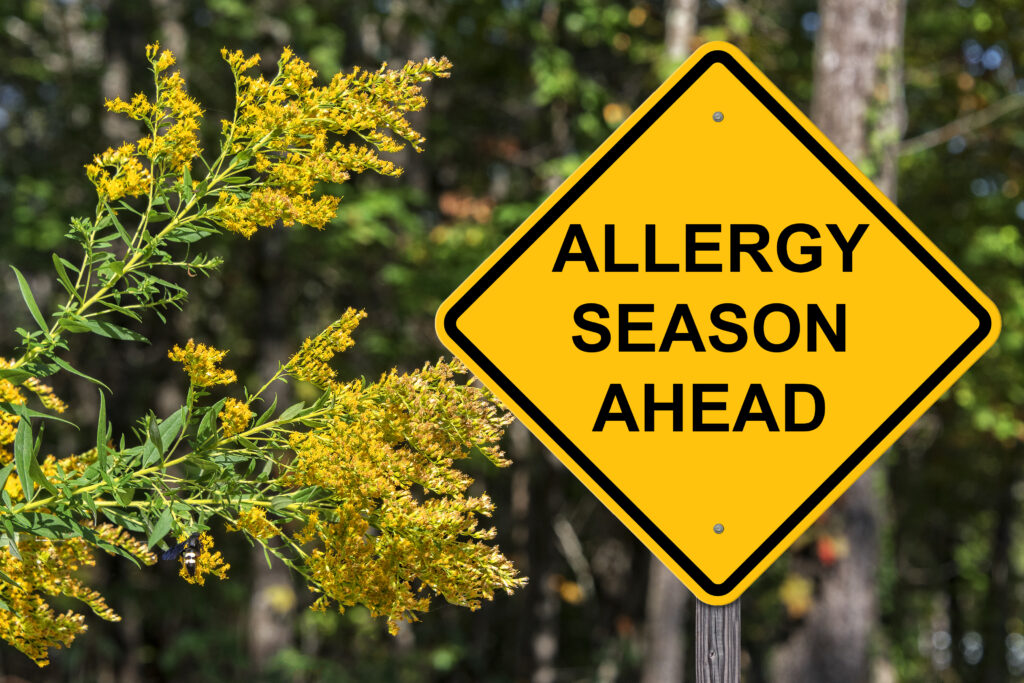Environmental Allergies affect millions of Americans, and their impact extends beyond seasonal sniffles to potentially life-threatening conditions like asthma. In this article we will answer the most frequently asked questions about environmental allergies and explore the relationship between allergies and asthma.

Environmental allergies, also known as allergic rhinitis or hay fever, occur when the immune system overreacts to substances in the environment that are typically harmless, such as pollen, mold spores, pet dander, dust mites, or certain foods. These allergens trigger allergic reactions, leading to symptoms like sneezing, congestion, itching, and watery eyes.
The most common environmental allergens include pollen from trees, grasses, and weeds, mold spores, dust mites, pet dander (from cats, dogs, or other furry animals), and certain foods. These allergens can vary depending on geographic location and seasonal factors.
Symptoms of environmental allergies may include sneezing, stuffy or runny nose, itchy or watery eyes, scratchy throat, coughing, wheezing, and fatigue. In severe cases, allergies can also trigger asthma symptoms or lead to skin reactions like hives or eczema.
Environmental allergies are typically diagnosed through a combination of medical history, physical examination, and allergy testing. Allergy testing may include skin prick tests or blood tests to identify specific allergens that trigger allergic reactions in an individual.
Environmental allergies are triggered by substances in the environment, such as pollen, mold, or pet dander, while food allergies are triggered by specific foods like peanuts, shellfish, or dairy products. Both types of allergies involve an immune system response, but they have different triggers and symptoms.
Yes, environmental allergies can develop at any age, even in adulthood. While some individuals may have allergies since childhood, others may develop allergies later in life due to changes in the immune system, environmental exposures, or genetic factors.
To prevent environmental allergies, you can take several measures such as avoiding allergens whenever possible, keeping indoor air clean with air purifiers or filters, using allergen-proof bedding covers, regularly cleaning your home to remove dust and mold, and keeping pets out of bedrooms or off furniture if you’re allergic to pet dander.
Some natural remedies for environmental allergies include nasal saline rinses, steam inhalation, using local honey, consuming certain herbal teas (such as nettle leaf or chamomile), taking supplements like quercetin or vitamin C, and practicing relaxation techniques like yoga or meditation to reduce stress, which can exacerbate allergy symptoms.
Air purifiers help remove airborne allergens like pollen, dust mites, mold spores, and pet dander from indoor air, thus reducing exposure to allergens and alleviating allergy symptoms. HEPA (High-Efficiency Particulate Air) filters are particularly effective at capturing small particles and allergens.
Some foods may have anti-inflammatory or antihistamine properties that can help alleviate environmental allergy symptoms. These include foods rich in omega-3 fatty acids (such as fatty fish), fruits and vegetables high in vitamin C (like oranges, strawberries, and bell peppers), and foods containing quercetin (such as onions, apples, and berries).

Yes, pets can cause environmental allergies in susceptible individuals due to proteins found in their dander, saliva, or urine. Pet dander, in particular, is a common allergen that can trigger allergic reactions like sneezing, itching, and congestion in people with pet allergies.
The best allergy medications for environmental allergies include antihistamines (such as loratadine, cetirizine, or fexofenadine) to relieve sneezing, itching, and runny nose, as well as nasal corticosteroids (like fluticasone or mometasone) to reduce nasal congestion and inflammation. Other options include decongestants, nasal sprays, or allergy shots (immunotherapy) for long-term allergy management.
Allergy symptoms (such as sneezing, itchy eyes, and clear nasal discharge) tend to be more persistent and occur in response to specific triggers (like pollen or pet dander), while cold symptoms (such as fever, body aches, and thick mucus) often come on gradually and may be accompanied by other signs of illness like fatigue or sore throat.
Yes, environmental allergies can trigger asthma symptoms or exacerbate existing asthma in some individuals, leading to wheezing, coughing, chest tightness, and difficulty breathing. This is known as allergic asthma and is often triggered by allergens like pollen, mold, dust mites, or pet dander.
To manage environmental allergies during pollen season, you can take several steps such as staying indoors during peak pollen times (usually early morning and late afternoon), keeping windows closed and using air conditioning, wearing a mask when doing outdoor activities, showering and changing clothes after being outdoors, and taking allergy medications as prescribed by your doctor.
Some alternative treatments for environmental allergies include acupuncture, acupressure, herbal remedies (such as butterbur or stinging nettle supplements), homeopathy, and essential oils (like lavender or eucalyptus) for aromatherapy or steam inhalation. However, the effectiveness of these treatments may vary, and it’s essential to consult with a healthcare professional before trying any alternative therapies.
To reduce dust mites in your home and alleviate allergies, you can take several measures such as washing bedding in hot water weekly, using allergen-proof mattress and pillow covers, vacuuming carpets and upholstery regularly with a HEPA-filtered vacuum, keeping humidity levels below 50% to discourage dust mites, and minimizing clutter to reduce dust accumulation.
While environmental allergies cannot be cured, they can be managed effectively with proper treatment and allergy management strategies. This may include allergen avoidance, medication, immunotherapy (allergy shots or sublingual tablets), and lifestyle modifications to reduce exposure to allergens and alleviate symptoms.
Yes, several lifestyle changes can help reduce environmental allergy symptoms, such as avoiding outdoor activities during high pollen counts, keeping windows closed during peak pollen seasons, using air purifiers or filters indoors, regularly cleaning your home to remove dust and mold, and maintaining a healthy diet and lifestyle to support immune function.
If your allergy symptoms worsen or become severe, it’s essential to seek medical attention from a healthcare professional, such as an allergist or primary care physician. They can help identify the cause of your symptoms, adjust your treatment plan as needed, and provide additional support or referrals for allergy testing or specialist care if necessary.

The relationship between allergies and asthma is intricate and often interconnected. Many individuals with asthma also have allergies, and allergic reactions can trigger or exacerbate asthma symptoms in these individuals. This connection is commonly referred to as allergic asthma.
When someone with allergic asthma comes into contact with allergens such as pollen, mold, dust mites, pet dander, or certain foods, their immune system overreacts, causing inflammation and swelling in the airways. This immune response can lead to asthma symptoms such as wheezing, coughing, chest tightness, and difficulty breathing.
Allergic asthma is one of the most common types of asthma, affecting a significant portion of asthma sufferers. However, not all asthma cases are directly linked to allergies, as asthma can have various triggers, including respiratory infections, exercise, cold air, irritants (like smoke or pollution), or even emotional stress.
The relationship between allergies and asthma highlights the importance of managing both conditions comprehensively. Effective management often involves:
By addressing both allergies and asthma comprehensively, individuals can better manage their symptoms, improve their quality of life, and reduce the risk of asthma exacerbations or complications. If you or a loved one are suffering from severe allergies or asthma we suggest you schedule a consult with Dr. Daniel Hamilos, a distinguished allergy doctor at the Maon City Clinic who specializes in treating such conditions and can develop a personalized treatment plan tailored to your specific needs and triggers. Please call our ENT and Allergy Department at 641.494.5380
Up-to-date. Down-to-earth. Close to home. Lots of great reasons to make Mason City Clinic
your first choice for all your family’s specialty healthcare needs.
250 S. Crescent Drive, Mason City, IA 50401
Tel: 641.494.5200
Toll Free: 800-622-1411
Fax: 641.494.5403